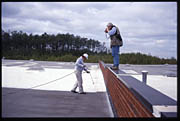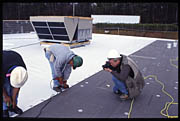Roofing in the National Spotlight
If you buy into the idiomatic phrase, "A picture is worth a thousand words," you would likely be a fan of National Geographic. I have been a magazine aficionado since my youth, and NG has always been a favorite because of its tradition of excellence in photojournalism. As such, you can imagine my excitement when Roofing Contractor was invited to escort Jay Dickman, NG photographer, on a photo shoot of cool roofing jobs-in-progress.

Story of the Story
Kurt Mutchler, NG picture editor, first contacted us in December 2002. He made his way to Roofing Contractor on the recommendation of our good friend Lucie Griggs of Cool Communities (www.coolcommunities.org). The mission of Cool Communities is "to promote healthy and livable communities by advocating urban heat island mitigation using sustainable cost-effective strategies for development, construction and existing structure retrofitting."Mutchler was interested in obtaining photographs for a feature article he was working on about the weather. NG wanted specifically to photograph cool roofing being applied in Atlanta. Atlanta is one of a number of metropolitan communities where NASA and others have studied the "urban heat island effect" over a period of years (www.ghcc.msfc.nasa.gov/urban/).
As it was explained to us at the time, the NG article was set to focus on all facets of the weather, and a point of interest was the how urban heat islands affect weather in major metropolitan areas. A focal point of the work NASA has done regarding the urban heat island phenomenon is its infrared satellite images taken over a period of years. These images dramatically portray how the surface temperature of the planet may be impacted by rapid growth in urban areas. The NASA study, along with a number of others, seeks to correlate rapid growth and the effect it has on weather and air pollution.
Cool Communities and a growing number of other interests put forward the idea that this increase in the surface temperature may be mitigated by increasing forestation and by using reflective surfaces on roofing and paving. Cool Communities also promotes the use of additional insulation as a way of conserving energy and reducing pollution.
We have learned that the feature article, "Fire and Rain-Forecasting the Chaos of Weather," is set to run in the June 2005 issue of National Geographic following several years of work and a few schedule changes. As daily combatants in the "Chaos of Weather," roofing contractors will not want to miss this issue.
Of course, we in the roofing and construction industries are not the only ones with an interest in the weather. According to Mutchler, the idea to produce a feature on the weather came from a previous article on the phenomena of El Nino-La Nina, which was very popular with readers. This article, written by Tim Brookes, explores the science of the study of weather and is a natural follow up. Mutchler also cites the popularity of weather in our culture, examples of which are tens of millions of viewers of The Weather Channel and visitors to its Web site, www. weather.com. We will let the feature speak for itself; just be sure to pick up a copy of the June National Geographic.

The Cool Roof Story in one Photo
The call to escort Dickman on a couple of roofing jobs seemed not only exciting, but a relatively easy task. As with many things in our business, it was not so simple. To begin with, we had to deal with Atlanta weather in January. Like many places, the weather here has a mind all its own and made scheduling the photo shoot a bit difficult. A largely overcast couple of days did yield sufficient periods of good light and Dickman was able to work around it just fine.
The photographic mission as Jay Dickman described it was to capture the story of highly reflective roofing with one photograph. His vision was to take the picture while the cool roofing was being installed, and preferably cast against a dark background. He was on his own, together with his formidable talent and experience, as we were only along for the ride. We took Dickman to see cool roofing being applied in two distinctly different scenarios: application of a white roof coating over a four-ply BUR and application of single-ply membrane on a new construction project.
A Cool Topper
We were fortunate to have the assistance and cooperation of two Atlanta contractors, one a commercial roofing contractor and the other a spray-coatings contractor. Our spray-coatings applicator was Max Holder, owner of Specialized Restoration Service LTD, also known as SRS Limited. Specializing in roof and wall coatings, Holder does a good deal of his work as a subcontractor for roofers. His work is 85 percent roof coating and the balance is a mix of exterior wall coatings and maintenance work.Holder got his start in the business around the time that he was between a career in sales and marketing management and taking a year or two off to write the great American novel (as yet unpublished, but stay tuned). He got his start in the business as a volunteer managing a project for his condominium complex. One thing led to another, and 12 years later SRS Limited employs eight, stays very busy, and has a respectable annual sales volume of around $1 million.
Holder tells us the thing he likes best about the work is making customers happy. That does not diminish his love for the technical aspects of the coatings application business. His job frequently includes recommending and specifying application processes and materials, as well as applied mil thickness. Like all coatings applicators and roofing contractors, his work is constantly at the mercy of the weather.
With the uncertainty of the weather and Holder's schedule of work, it was decided to "stage" a roof-coating job. Holder routinely puts a reflective surfacing on smooth-surfaced BUR jobs six to nine months after they are installed. Building owners appreciate the fact that their buildings are cooler inside, and the life of the membrane is greatly enhanced by the protection received from the white surface. So this was both a "staged" and a "real" job. Holder just began the job without a full crew on board and simply sprayed a few rows of white coating while Dickman photographed him.
A Cool Membrane
Thankfully the weather cooperated on the day we escorted Dickman to shoot photos of a white-surfaced TPO system being installed by Mid-South Roof Systems Inc. of Atlanta. This was the job that produced the one photograph of cool roofing that you will see in the June National Geographic article. Having seen an advance copy of the photo, I can tell you that it really does capture the essence of "highly reflective roofing" on a commercial building.Mid-South Roof Systems president and general manager, Ron Newton, joined us on the job at the Camp Creek Marketplace in Atlanta. The single-ply roofing system consisted of a layer of polyiso roof insulation mechanically fastened to a metal deck followed by a mechanically fastened Firestone UtraPly TPO membrane with heat-welded seams.
Newton founded Mid-South in 1990 following higher education, a few years in the U.S. Air Force, and several stints in the construction field-capped by five years working with a roofing contractor. Newton learned a great deal from his construction experience and was especially drawn to the role of the subcontractor. He notes that when working as a subcontractor, the pace is faster, there is more variety, and "You're never bored."
Specializing in single-ply roofing from the beginning, Mid-South performs a wide variety of commercial roofing services, including built-up and modified. Around three quarters of the firm's work is new construction, and in a partnership with Cody Findley, Mid-South Metal Systems of Macon, Ga., provides metal roofing capabilities. Newton has built the business to $35 million in annual sales and employs roughly 200.
Being involved in commercial roof contracting can be challenging enough, but managing a sizable volume of new construction work is particularly difficult in these days of escalating prices and diminished materials availability. Every order for polyiso insulation has to be managed, and the materials must be dealt with in order to assure quality storage. Speaking of the problems associated with the supply of polyiso insulation, Newton says the situation is, "The worst I've ever seen in this business."
Newton credits the people associated with Mid-South Roof Systems for the success the firm has enjoyed. Newton says, "We try to do things right and honest ... so that the customer gets the best service and product." He goes on to say, "Our employees are rewarded for what they do ... stretched, challenged... and enjoy what they do."
A Cool Thing for the Roofing Industry
The whole idea of joining a National Geographic photographer on a photo shoot was a big deal to me personally. I think having the spotlight shined on cool roofing in a commercial application is a big deal for our entire industry. We know-and our building-owner clients are learning-that the right roofing system on a commercial building can drastically improve the energy efficiency of the overall structure. This article will further point out to the general public how we are discovering that a reflective-membrane roof can even help to improve the air quality of their community.Most people do not even think about a roof on a commercial structure. The ones who do would typically think of a commercial roof as simply a way to keep the water out. This article points out (to the 40 million NG readers) that it can be so much more. And that is a good thing for the roofing industry.
Looking for a reprint of this article?
From high-res PDFs to custom plaques, order your copy today!







